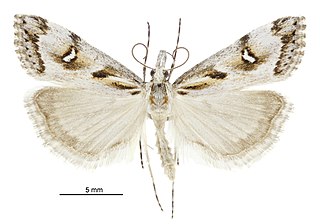
Lichenaula lichenea is a species of moth of the family Xyloryctidae. It is known in Australia from the Australian Capital Territory, New South Wales and Queensland.

Agdistopis halieutica is a moth in the Macropiratidae family. It is found from Australia and New Guinea to Fiji.

Gadira leucophthalma, the beaked moss moth, is a moth in the family Crambidae. It is endemic to New Zealand. It is found in the south eastern side of the South Island down to Banks Peninsula. G. leucophthalma inhabits the foredunes of coastal areas. The larval host is unknown but it has been hypothesised that the larvae feed on moss. The adult moths are day flying although some specimens have been trapped at night via light traps. Adults are commonly on the wing from March to April. This species has been classified as Nationally Vulnerable by the Department of Conservation.
Helcystogramma rhabduchum is a moth in the family Gelechiidae. It was described by Edward Meyrick in 1911. It is found in Sri Lanka and India.
Hypatima isotricha is a species of moth in the family Gelechiidae. It was described by Edward Meyrick in 1921. It is found on Java in Indonesia.
Charistica ioploca is a moth in the family Gelechiidae. It was described by Edward Meyrick in 1922. It is found in Amazonas, Brazil.
Photodotis prochalina is a moth of the family Gelechiidae. It was described by Edward Meyrick in 1911. It is found in South Africa.
Thiotricha polyaula is a moth of the family Gelechiidae. It was described by Edward Meyrick in 1918. It is found in Assam, India.
Polyhymno hieracitis is a species of moth of the family Gelechiidae. It was described by Edward Meyrick in 1913. It is found in South Africa (Mpumalanga).
Antaeotricha compsographa is a moth of the family Depressariidae. It was described by Edward Meyrick in 1916. It is endemic to French Guiana.
Deltoplastis caduca is a moth in the family Lecithoceridae. It was described by Edward Meyrick in 1910. It is found in Assam, India.
Comocritis thespias is a moth in the family Xyloryctidae. It was described by Edward Meyrick in 1909. It is found in Sri Lanka.
Comocritis olympia is a moth in the family Xyloryctidae. It was described by Edward Meyrick in 1894. It is found in Myanmar and Assam, India.
Mimozela is a monotypic moth genus in the family Depressariidae. Its only species, Mimozela rhoditis, is found in Australia, where it has been recorded from Queensland. Both the genus and species were first described by Edward Meyrick in 1914.
Aeolanthes callidora is a moth in the family Depressariidae. It was described by Edward Meyrick in 1907. It is found in India (Assam).
Aeolanthes dicraea is a moth in the family Depressariidae. It was described by Edward Meyrick in 1908. It is found in India (Assam).
Filinota lamprocosma is a moth in the family Depressariidae. It was described by Edward Meyrick in 1916. It is found in French Guiana.
Antaeotricha sardania is a moth in the family Depressariidae. It was described by Edward Meyrick in 1925. It is found in Brazil (Para) and Peru.
Antaeotricha stringens is a moth in the family Depressariidae. It was described by Edward Meyrick in 1925. It is found in Brazil.
Stenoma neurotona is a moth in the family Depressariidae. It was described by Edward Meyrick in 1915. It is found in Guyana.


